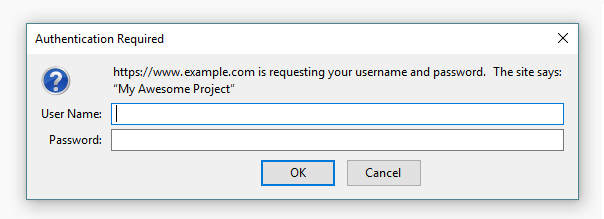

How to connect to a Subversion repository
source link: https://help.dreamhost.com/hc/en-us/articles/215465898-How-to-connect-to-a-Subversion-repository
Go to the source link to view the article. You can view the picture content, updated content and better typesetting reading experience. If the link is broken, please click the button below to view the snapshot at that time.
How to connect to a Subversion repository
Subversion has been removed from the DreamHost panel. If you had previously configured Subversion on your domain, it will continue to function normally.
Overview
This article lists several ways you can connect to your SVN repository.
Connecting with your browser
- Navigate to the Subversion page.

- Under the list of current projects, click the link for your repository.
An authentication pop-up box then appears:

- Use the username and password you created when setting up the repository.
This loads your repository within your browser to view.
Connecting with a client
You can also connect with a 3rd party client. TortoiseSVN is a very popular choice.
Connecting via SSH (command line)
There are many commands you can run via SSH to connect and manage your repository. Below are some of the most common commands.
Checkout
This command performs a checkout of your repository:
[server]$ svn co https://example.com/exampleProjectID/
If you run this in your user's directory, a new folder is created. It's named the same as your projectID, and you have now created a 'Working Copy' of your repository on your local machine. For further information, please visit the following page:
Importing
Once the repository is created, you can add folders and files that you have in another location. It is better to use this method to keep the revisions number down when first creating the repository. Make sure to change username to your Shell user, and path/to/source to the location of your file.
[server]$ svn import /home/username/path/to/source file:///home/username/path/to/repository --message="Importing Project"
Updating
To ensure your Working Copy is using the most recent revision, run svn update:
[server]$ svn update
For further details, please visit the following page:
Adding
Once you have a working copy, you can now add files or directories to it. For example, if you add a file named myfile.txt to the working copy directory, you must then run 'svn add' to actually add it to the working copy.
[server]$ svn add myfile.txt
Once it's added, you can now commit your changes to the repository.
Committing
After you have made all of your adjustments, you'll need to commit the changes to the repository.
[server]$ svn commit -m "log messages"
This command commits all changes. The -m flag allows you to leave a message as to what and why you have committed in this specific revision.
Listing
Running the list command with the --verbose flag lists the following information:
- Revision number of the last commit
- Author of the last commit
- Size (in bytes)
- Date and time of the last commit
[server]$ svn list --verbose
See also
Did this article answer your questions?
Recommend
About Joyk
Aggregate valuable and interesting links.
Joyk means Joy of geeK